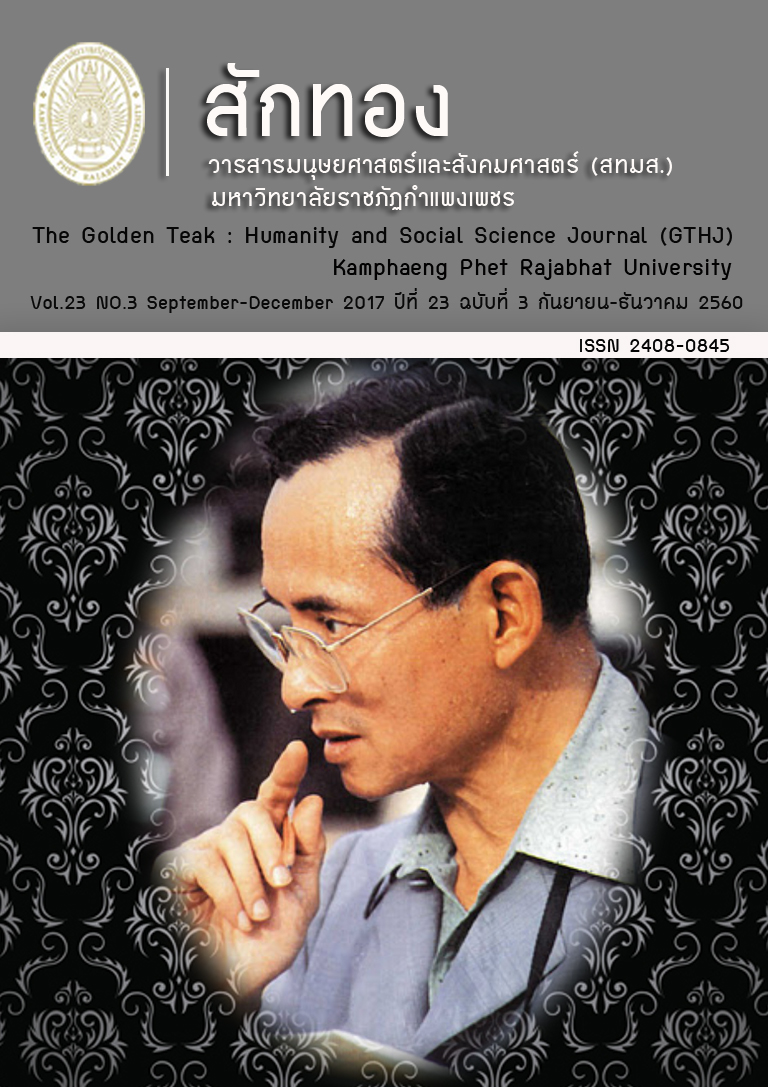การพัฒนารูปแบบการเรียนรู้ร่วมกัน เพื่อส่งเสริมความสามารถการสื่อสารวิชาวิทยาศาสตร์ สำหรับนักเรียนชั้นมัธยมศึกษาตอนปลาย
Main Article Content
Abstract
บทคัดย่อ
การวิจัยครั้งนี้มีวัตถุประสงค์เพื่อพัฒนารูปแบบการเรียนรู้ร่วมกันเพื่อส่งเสริมความสามารถการสื่อสารวิชาวิทยาศาสตร์สำหรับนักเรียนชั้นมัธยมศึกษาตอนปลาย การวิจัยดำเนินการตามกระบวนการวิจัยและพัฒนาแบ่งออกเป็น 2 ขั้นตอน คือ ขั้นตอนที่ 1 การสร้างและหาคุณภาพของรูปแบบการเรียนรู้ โดยผู้เชี่ยวชาญ 9 ท่าน และทดลองนำร่องเพื่อพิจารณาความเป็นไปได้กับนักเรียนที่ไม่ใช่กลุ่มตัวอย่าง จำนวน 32 คน ขั้นตอนที่ 2 การศึกษาผลการทดลองใช้รูปแบบการเรียนรู้ โดยนำไปทดลองใช้กับนักเรียนชั้นมัธยมศึกษาปีที่ 4 โรงเรียนองค์การบริหารส่วนจังหวัดเพชรบูรณ์ (วังชมภูวิทยาคม) สังกัดองค์การบริหารส่วนจังหวัดเพชรบูรณ์ กรมส่งเสริมการปกครองท้องถิ่น กระทรวงมหาดไทย ในภาคเรียนที่ 1 ปีการศึกษา 2559 จำนวน 31 คน ผลการวิจัย พบว่า 1) รูปแบบการเรียนรู้ร่วมกันเพื่อส่งเสริมความสามารถการสื่อสาร วิชาวิทยาศาสตร์สำหรับนักเรียนชั้นมัธยมศึกษาตอนปลาย มีองค์ประกอบ 5 องค์ประกอบ ได้แก่ หลักการ วัตถุประสงค์ เนื้อหา กระบวนการจัดการเรียนรู้ซึ่งประกอบด้วย 5 ขั้นคือขั้นสร้างสภาพแวดล้อม และกระตุ้นการเรียนรู้ ขั้น ร่วมสร้างความเข้าใจในการเรียนรู้ ขั้นร่วมกันวางแผนการเรียนรู้ ขั้นร่วมสร้างองค์ความรู้และขั้นร่วมกันสรุปและประเมินผลการเรียนรู้ และการวัดและประเมินผล ผลการตรวจสอบคุณภาพโดยผู้เชี่ยวชาญ พบว่า รูปแบบการเรียนรู้ที่พัฒนาขึ้นมีความเหมาะสมอยู่ในระดับมาก เมื่อนำไปทดลองใช้พบว่า ดัชนีประสิทธิผลของรูปแบบการเรียนรู้ 0.67 2) ผลการทดลองใช้รูปแบบการเรียนรู้ร่วมกัน เพื่อส่งเสริมความสามารถการสื่อสาร วิชาวิทยาศาสตร์สำหรับนักเรียนชั้นมัธยมศึกษาตอนปลาย พบว่า 2.1) นักเรียนมีความสามารถการสื่อสาร หลังเรียนสูงกว่าก่อนเรียน อย่างมีนัยสำคัญทางสถิติที่ระดับ .05 2.2) นักเรียนมีความสามารถการสื่อสารหลังเรียนสูงกว่าเกณฑ์ ร้อยละ 70 อย่างมีนัยสำคัญทางสถิติที่ระดับ .05 2.3) ผลการศึกษาพฤติกรรมการเรียนรู้ร่วมกัน 2.3.1) ด้านการร่วมกันวางแผนการศึกษาค้นคว้าแก้ปัญหา พบว่านักเรียนสามารถแสดงออกถึงการ ร่วมกันวิเคราะห์ กำหนดประเด็น การจัดเรียงแบ่งลำดับความสำคัญทำความเข้าใจกับสถานการณ์ปัญหาและแสดงความสัมพันธ์เชื่อมโยงอย่างเป็นขั้นตอนได้ 2.3.2) การแบ่งบทบาทหน้าที่ในการทำกิจกรรม พบว่าเมื่อนักเรียนสามารถแสดงออกถึงการจัดแบ่งหน้าที่ในการสืบเสาะหาความรู้ และยอมรับหน้าที่ของกันและกันภายในกลุ่มและมีความรับผิดชอบเป็นรายบุคคลสามารถปฏิบัติกิจกรรมตามที่ได้รับมอบหมาย มีความยืดหยุ่นในหน้าที่และช่วยเหลือซึ่งกันและกันได้ 2.3.3) การร่วมกันแสดงความคิดเห็นแลกเปลี่ยนเรียนรู้ พบว่านักเรียนสามารถแสดงออกถึงการระดมความคิด การแลกเปลี่ยนเรียนรู้จากผลการสืบเสาะหาความรู้ของตนกับสมาชิกภายในกลุ่ม มีการสลับการสอนระหว่างผู้เรียนด้วยกันเองโดยการจับคู่อภิปรายและถ่ายถอดไปยังกลุ่มและแลกเปลี่ยนเรียนรู้ระหว่างผู้เรียนกับผู้สอน มีการใช้การอ้างอิงแหล่งข้อมูลที่เชื่อถือได้มาประกอบการทำกิจกรรมได้ 2.3.4 การร่วมกันดำเนินการในการจัดกระทำข้อมูลความรู้ พบว่านักเรียนสามารถแสดงออกถึงการร่วมกันแสดงการเรียงลำดับความสำคัญและความสำพันธ์ เชื่อมโยงของข้อมูลสารสนเทศ จากข้อค้นพบ ด้วยวิธีการอย่างหลากหลายได้
The Development of Collaborative Model to Promote Communicative Competence in Science for Upper Secondary Students
ABSTRACT
The purpose of this study was to develop a teaching (didactic) model to promote the communicative competence though collaborative work among upper secondary school students in the general sciences. This study therefore involves student understanding of scientific language. This study applied the Research and Development process to develop the Scientific Language Didactic Model (SLDM), a model for teaching scientific language. It consisted of the following 2 steps; 1) The development of a model. The model quality was evaluated according to 1.1) the outline of the model was assessed by 9 experts, 1.2) the model was tested with a class of 32 students, who had limited exposure to scientific discourse before. After evaluation, a few small changes were made to the work taught, but no changes were made to the model. 2) The model was implemented using the developed form with 31 Matthayom 4 students in Petchabun Provincial Administrative Organization School (Wangchomphu-Witthayakhom), affiliated to Petchabun Provincial Administrative Organization, Department of Local Administration, Ministry of Interior, in the 1st semester of the 2016 academic year. The results are as follows : 1. The results and the quality of the model were 1.1) the components of the model are Principles, Objectives, Contents, Learning Activities and Assessment. There are 5 steps in the learning activities; 1) Create a stimulating learning environment, 2) Group work, discussion and understanding of concepts 3) Group work planning, data collection, 4) Finding solutions and the understanding of concepts 5) Students review what they did in class. Teacher assessment of the lesson 1.2) the quality of the model was appropriate at a high level, and the effectiveness of the model was equal to 0.67. 2. The results of implementing the model are: 2.1) The student’s ability of communication in Science after learning was higher than before at the level of significance of .05. 2.2) It was higher than the 70 percent criterion at the level of significance of .05. 2.3) By observation of the students’ learning behavior. 2.3.1) The aspect of the collaboration in planning and problem solving found that the students are interested, enthusiastic, and involved collaborative planning and problem solving. 2.3.2) The aspect of Role Division and allocation: the students are able to take responsibility for their own part in the group activity, and change their roles in the group. 2.3.3) The aspect of the collaboration in learning sharing, the students can discuss and deliver presentations as demonstrated as part of their learning process. 2.3.4) The aspect of the collaboration in data collection and analysis, the students can link their knowledge with various subjects.
Article Details
บทความที่ได้รับการตีพิมพ์เป็นลิขสิทธิ์ของวารสาร สักทอง : วารสารมนุษยศาสตร์และสังคมศาสตร์ สถาบันวิจัยและพัฒนา มหาวิทยาลับราชภัฏกำแพงเพชร
ข้อคิดเห็นใดๆ ที่ปรากฎในวารสารเป็นวรรณกรรมของผู้เขียนโดยเฉพาะ ซึ่งมหาวิทยาลัยราชภัฏกำแพงเพชรและบรรณาธิการไม่จำเป็นต้องเห็นด้วย


